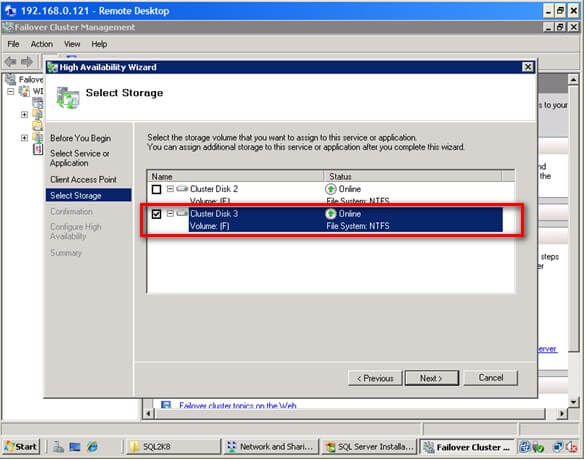Install Windows Server 2008 Cluster
- 1.2 Mount the Server 2008R2 ISO on the three virtual machines, and install Server 2008R2 Enterprise edition (Full Installation). Failover Clustering feature is included in Enterprise and Datacenter editions of 2008R2 only.
- To install an Officescan Server on a Windows 2008 Failover Cluster: Set up the failover cluster in Windows 2008. Go to Administrative Tools and then open Server Management. Click Features > Add Features and then select Failover Clustering in the selection screen. Finish adding the features on 2.
Despite being an older version, some applications may require you to install a SQL Server 2008 R2 clustered instance on a Windows 2012 environment. You will quickly find out that there are a number of compatibility issues that can make this task tricky. See below for a summary of the issues you can encounter and how to work around them in order to successfully install SQL Server. Cluster service verification rule failedThe first issue you may run into is during the Setup Support Rules step of the SQL installation wizard.
I just installed my first SQL Server 2005 x64 Enterprise Edition virtual server on a Windows 2008 Enterprise Edition Cluster. It is basically the same install as on Windows 2003. The major issues I noticed were compatibility issues for the installation of the SSIS and Business Intelligence Studio option.
Dec 05, 2017 If it's not possible to create a cluster on Windows Server 2008 R2 Standard Edition, why is this feature incorporated with this version of Windows Server? Actually I tried to create a cluster with 2 Windows Server 2008 R2 Standard Edition servers. SP1 is also installed into one of the servers.
After the installation it will not allow you to do the following:1) Create a Maintenace Plan - This throws some strange errors. I did find a work arround by opening the Studio and creating the SSIS package manually.2) Use Database Mail - you get the generic 'Activation Failure' error when looking at the DB mail log.I have opened a case with Microsoft for these issues.Visual Stuido 2005 is not compatible with Windows 2008 or Vista.My personal opinion is that you will need to install Visual Studio 2008. I finally had all my issues resolved with SQL 2005 on a Windows 2008 Cluster.There were several issues:1) Issues with SSPI handshakes when the service account was trying to use Kerberos over TCP/IP registering SPN(s) when bringing SQL service online in 'Failover Cluster Management'This was resolved by granting write and read access for the SQL startup account to add and remove SPN(s) (Server Principal Names) from AD.2) Problems with SP2 update. The service pack would install properly but when creating a maintenance plan it would fail.This was resolved by manually running the query sysdbupg.sql located in the C:Program FilesMicrosoft SQL ServerMSSQL.1MSSQLInstall folder.3) Problems with Database Mail using Basic Authentication.Remove mail profile and account. Here's my 2c on cluster install.
Install Windows Server 2008 Cluster Problems


I recently ran into an issue where SQL 2005 wouldn't install anything on a windows 2008 cluster and wanted to share the Microsoft solution. It all came down to a security setting that had recently been pushed out.Windows 2008 have a new policy:Network access: Do not allow storage of credentials or.NET Passports for network authentication = EnabledThis policy setting is seen in this registry location:KEY: HKEYLOCALMACHINESystemCurrentControlSetControlLsaVALUE: disabledomaincredsSETTING: 1SQL Server 2005 cluster installation requires the ability to cache credentials to run the Remote Task Scheduler on the passive nodes of the cluster during the setup process. This policy will not allow this to happen.

This is not a problem when doing a stand-alone SQL 2005 install, nor when doing a SQL 2008 cluster install as it doesn't use Remote Task Scheduler when installing on the passive nodes.? A similar issue is mentioned in the below KB article.912998 Error message when you try to automatically deploy agents in MOM 2005: 'A specified logon session does not exist. It may have already been terminated'Steps from Article:1. Click Start, click Run, type gpedit.msc, and then click OK.2. Under Computer Configuration, expand Windows Settings, expand Security Settings, expand Local Policies, and then expand Security Options.3. In the Policy pane, right-click Network access: Do not allow storage of credentials or.NET Passports for network authentication, click Properties, click to select Disabled, and then click OK.4. Click Start, click Run, type regedit, and then click OK.5.
Locate and then right-click the following registry subkey:HKEYLOCALMACHINESystemCurrentControlSetControlLsa6. Verify that the disabledomaincreds value is set to 0.7. Restart both nodes of the cluster.